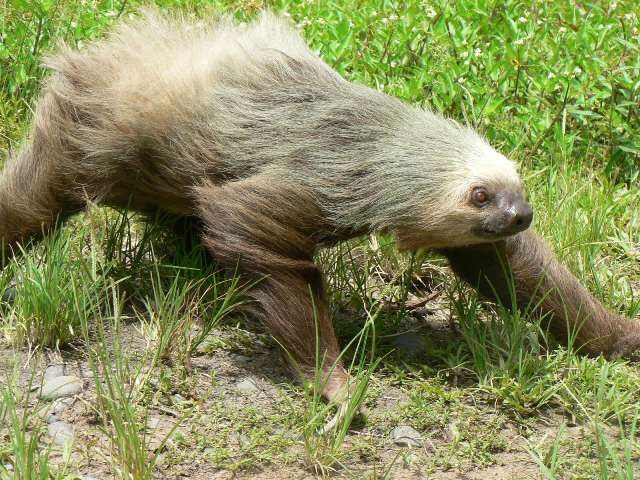Two-Toed Sloth
Two-Toed Sloth (Choloepus hoffmanni)Spanish Name: Perezoso de Dos Dedos

More about Two-Toed Sloth
Habitat
This sloth is active mostly in the canopy of tropical evergreen forests.
Range
Two-toed sloths live from northern Nicaragua to Ecuador.
Physical Description
This nocturnal sloth species is pale yellow with brownish limbs. They have two long toes on their front feet, as their name implies, instead of three like their similarly-named relatives. These toes have long claws well-suited for gripping and hanging on limbs and branches. Both the two-toed and three-toed sloths have three toes on the hind feet.
Interesting Biology
The two-toed is seen less frequently than the three-toed because it sleeps well-hidden in leaf masses during the day, and when curled up looks similar to a wasp nest. It has good night vision, and larger eyes and more of a snout than its three-toed relative. The two-toed also lacks a tail. It is more aggressive than the three-toed, and not as shy of people. It is a skilled swimmer, and in some places has been known to frequently cross streams to access more tree species.
The sloth body is specialized for a low intake of indigestible food, particularly mature leaves of forest trees. They use fewer resources per day than most mammals and have corresponding traits such as their famous lethargic behavior, long periods between defecating, and highly variable body temperature. This sloth occupies a home range of less than 2 ha and may use fifty trees of up to thirty species, eating leaves of different ages. They digest food very slowly, taking several days to do so. They descend from the canopy once a week to defecate. Mothers carry their young for a few months, so they have the opportunity to learn what to eat; then the mother leaves to a different part of her home range, bequeathing the first home range to the offspring.
There are more adult females found of this species than adult males, suggesting that there is spacing among males and competition for access to females. It is thought that their populations may have increased over the last few decades due to the disappearance of the harpy eagle, but this is not certain. The sloth is not threatened as much by natural terrestrial predators (such as boas or cats) as much as it is threatened by logging and general deforestation.
Diet
Sloths are specialized for eating leaves of trees and lianas; they will eat leaves from many different species, but they are also picky eaters.
Height/Weight
The two-toed sloth has a head and body length of 0.54 to 0.7 m, and weighs 5.7 kg.
Taxonomy
Order: Xenarthra
Family: Bradypodidae
Sources
Eisenberg, John. Mammals of the Neotropics, Vol. 1. The University of Chicago Press: Chicago, 1989.
Janzen, Daniel H. Costa Rican Natural History. Chicago: University of Chicago Press, 1983.
Laval, Richard K. Personal communication.
Wilson, D. E. in Janzen, Daniel H. Costa Rican Natural History. Chicago: University of Chicago Press, 1983.
Amy Strieter, Wildlife Writer
Two-Toed Sloth Sightings
Similar Profiles
We believe travel is more than ticking destinations off a list – it’s about discovering new places deeply, feeling connected wherever you go, and knowing you have a trusted team behind you every step of the way.



